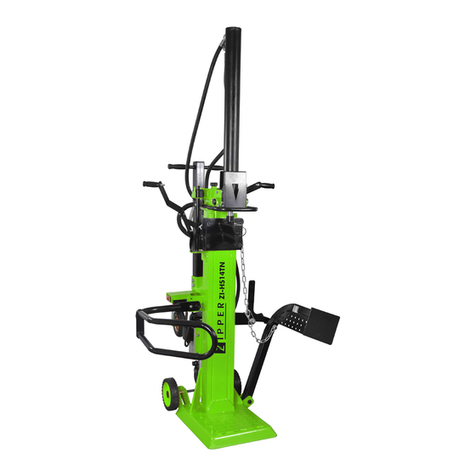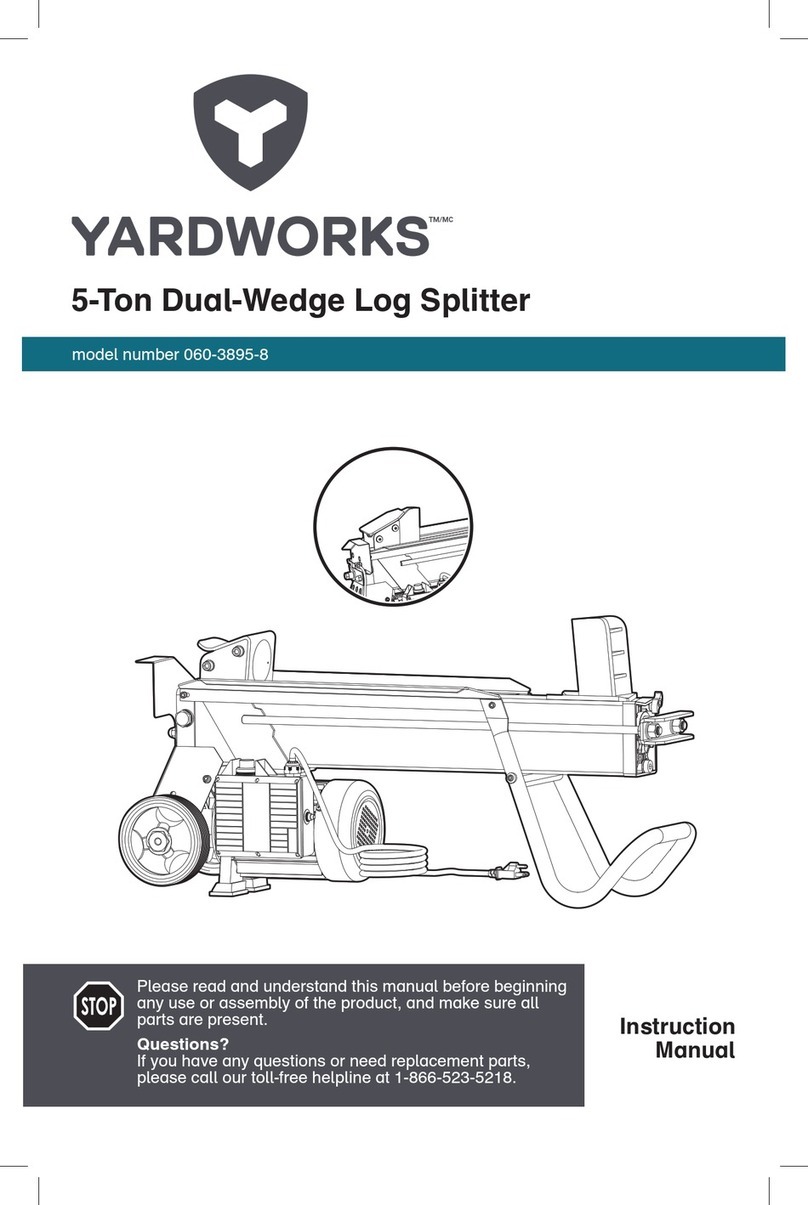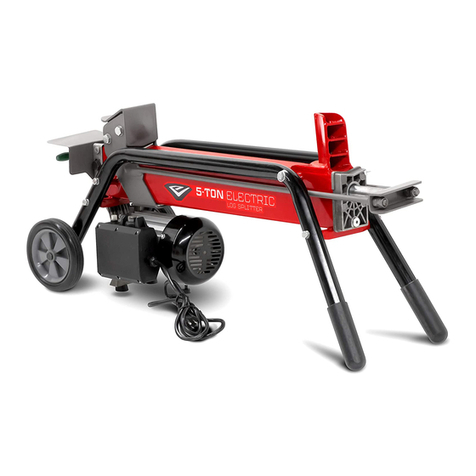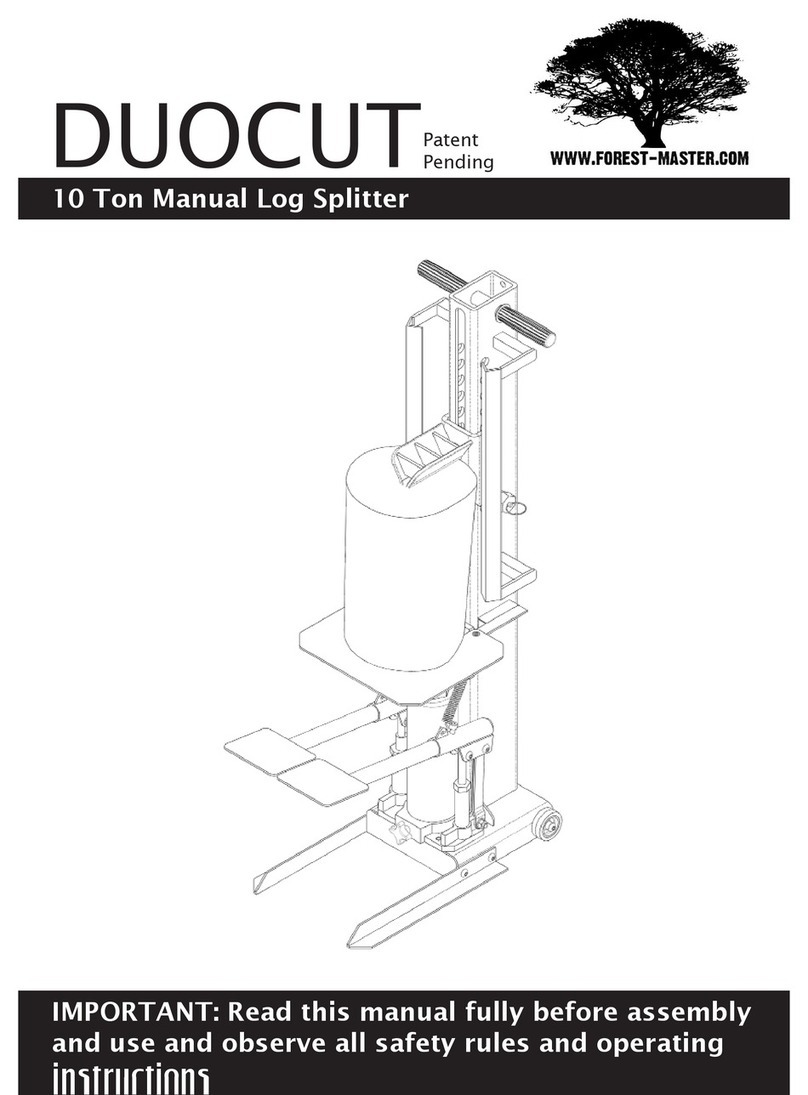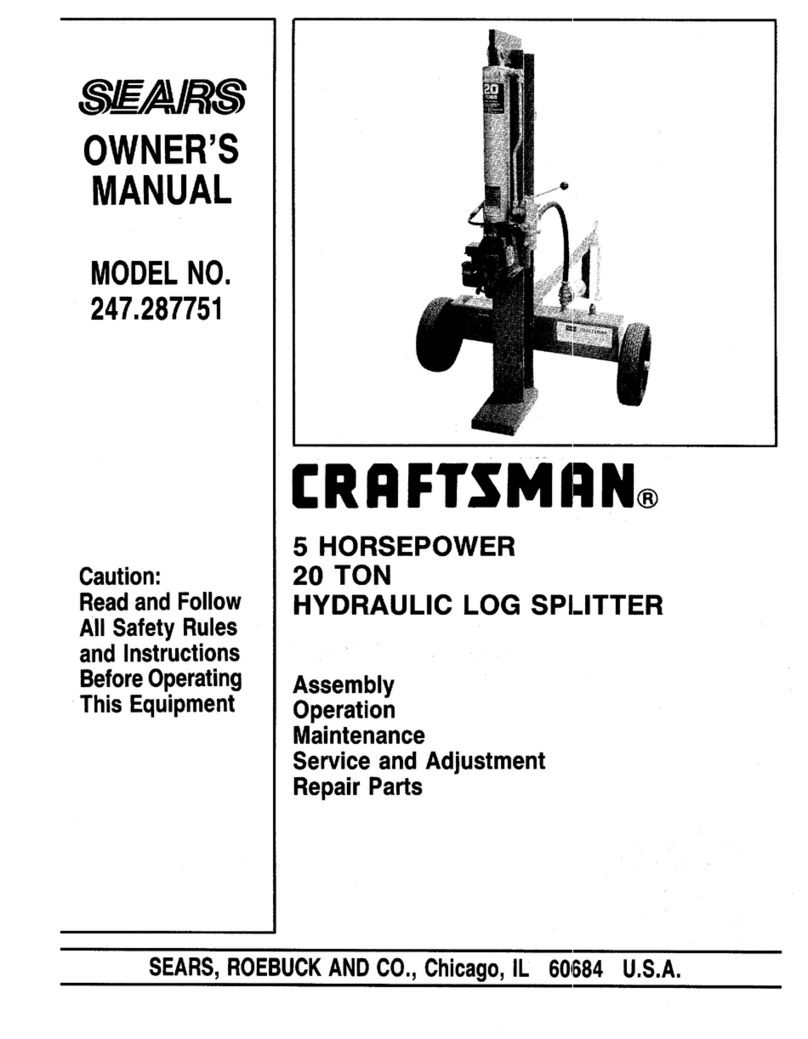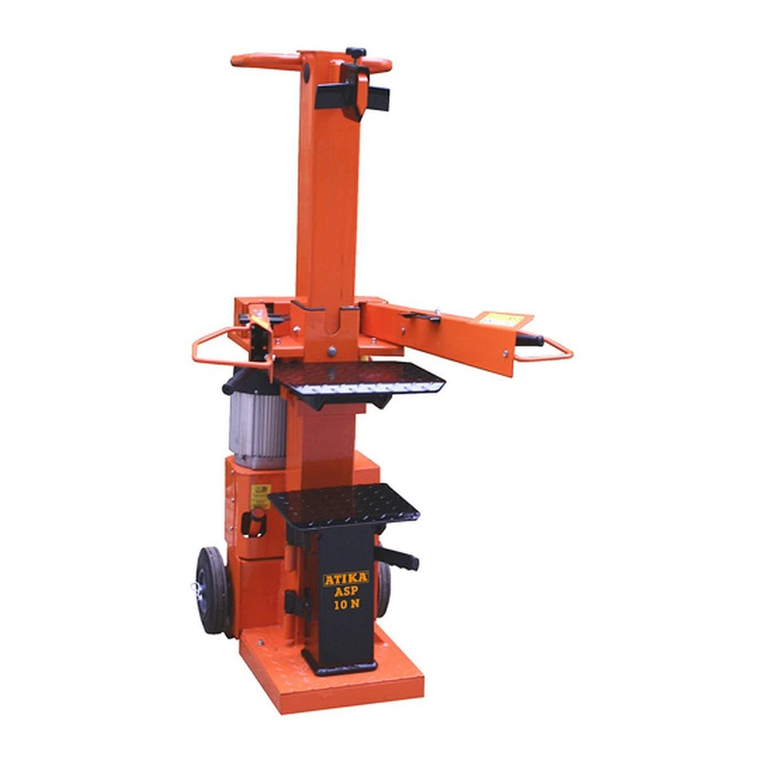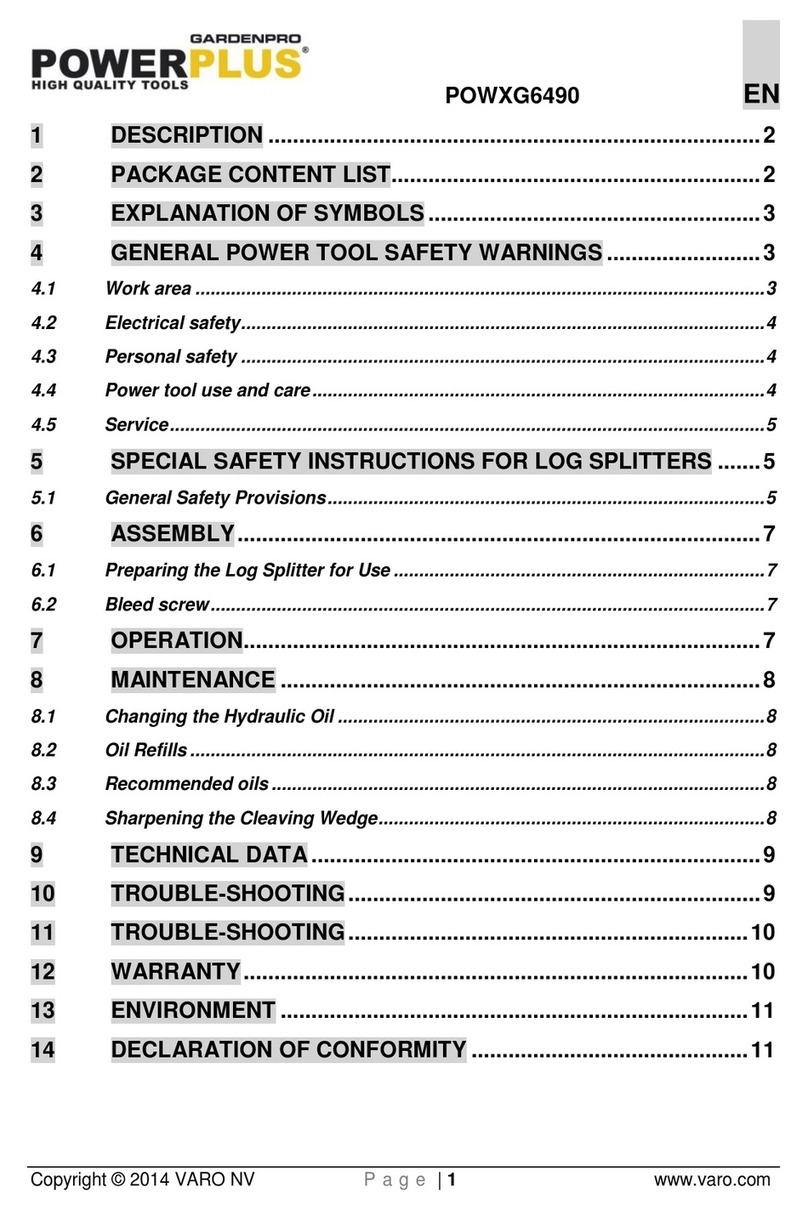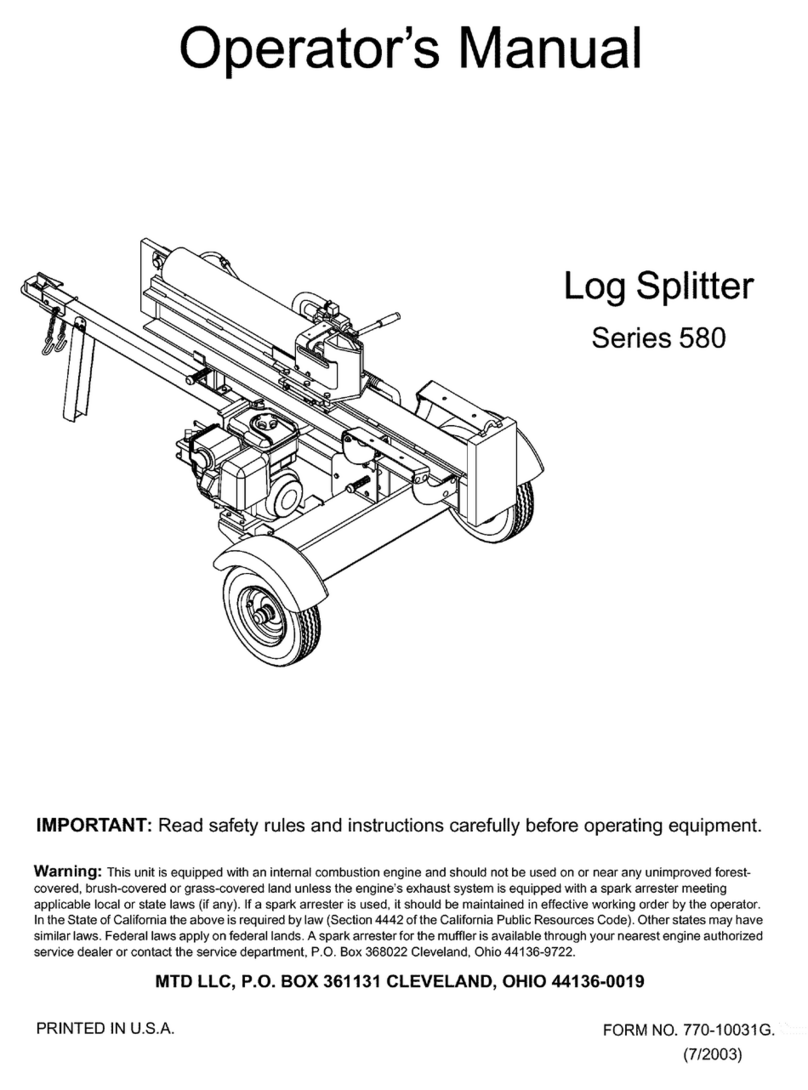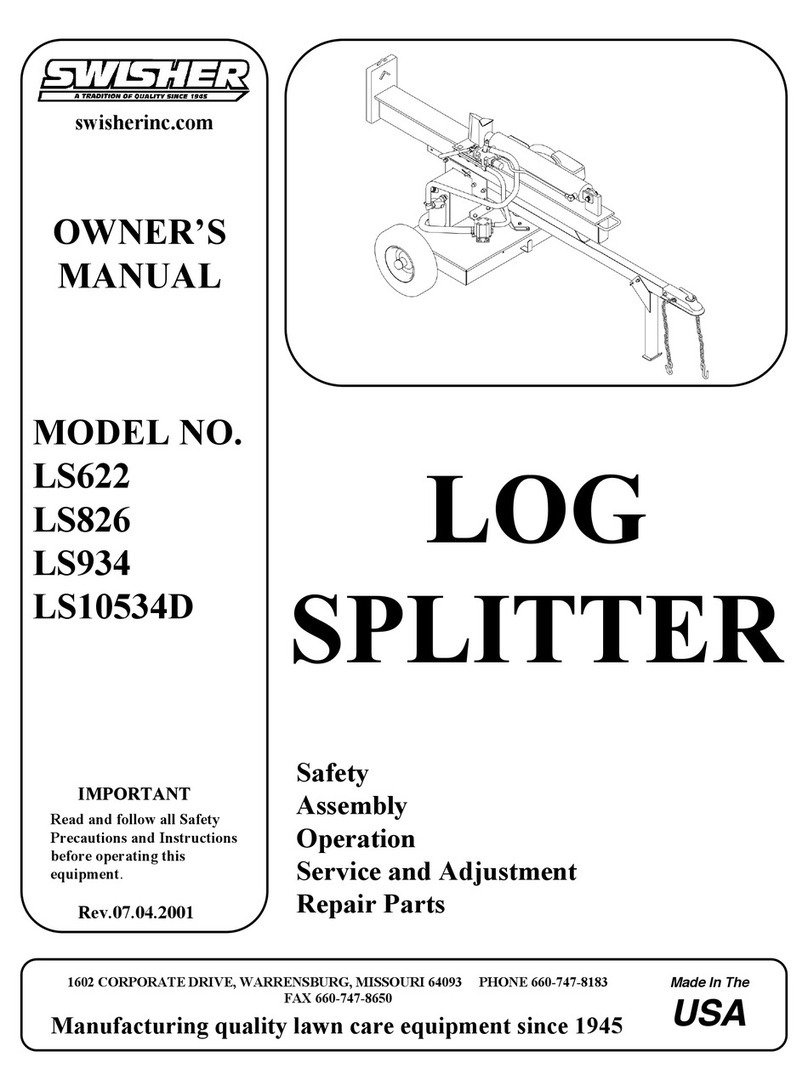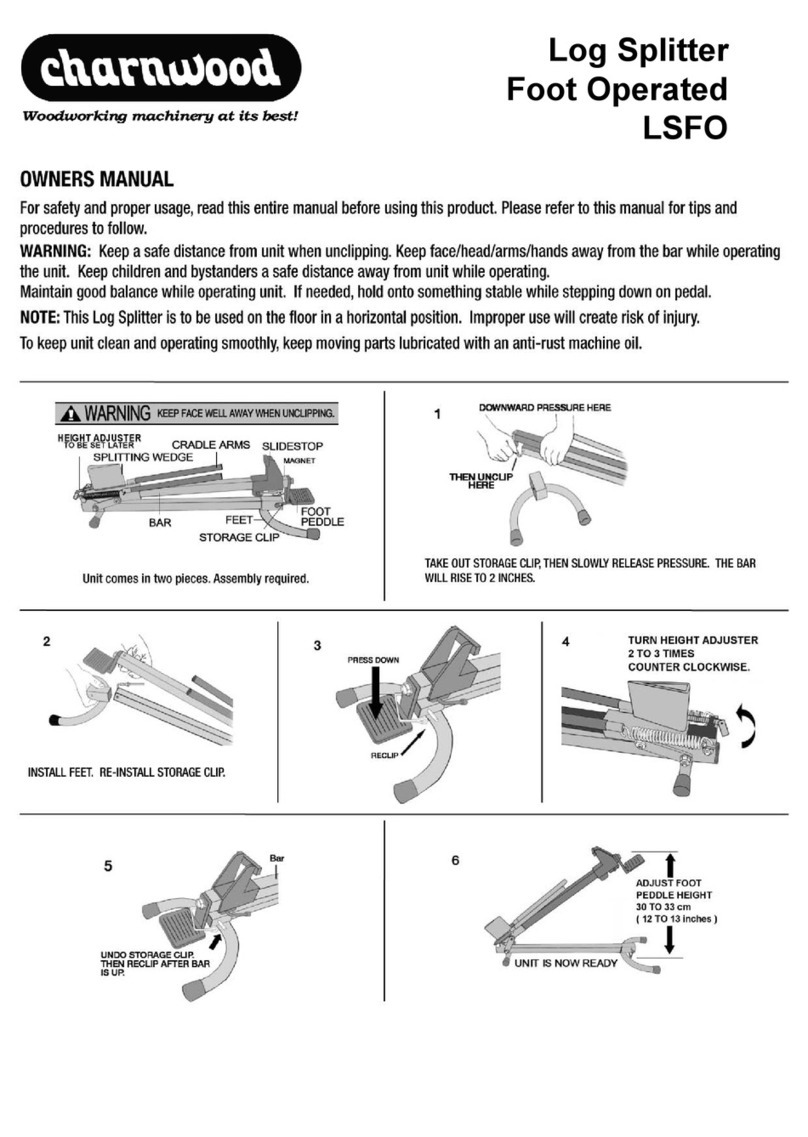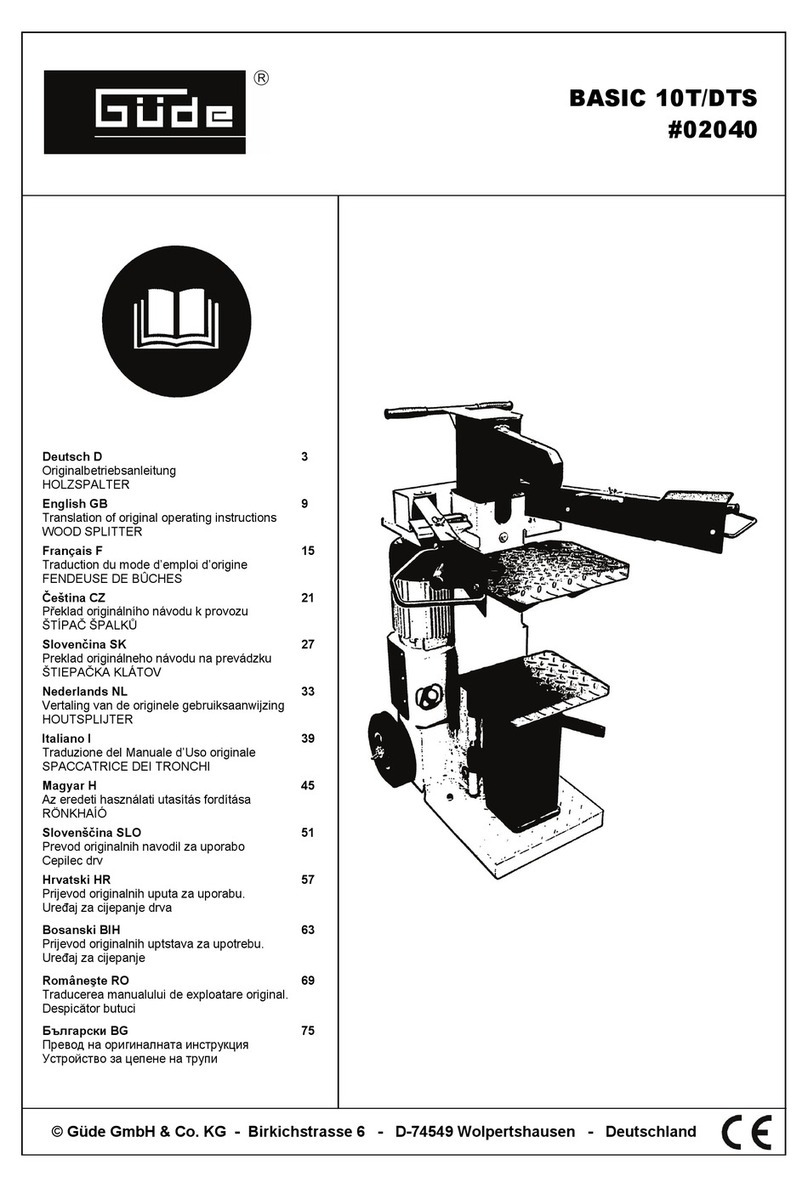FISCH LS 8000 User manual

12 x 20 Log Splitter
LS 8000 Type H
Instruction Manual

TABLE OF CONTENTS
SAFETY INSTRUCTIONS .........................................3,4
ELECTRICAL CONNECTIONS
Power Source ............................................................ 5
Extension Cords ........................................................ 5
Grounding Instructions .............................................. 5
UNPACKING MACHINE ...............................................6
ASSEMBLY INSTRUCTIONS
Installing Leg Assembly ............................................. 7
Attaching Operating Lever ......................................... 7
Attaching Wheel Bracket ........................................... 7,8
OPERATING CONTROLS, MAINTENANCE,
AND ADJUSTMENTS
Starting and Stopping Machine Cycle ....................... 8
Maintaining Proper Oil Level ..................................... 8
Adjusting Air Bleed Screw ......................................... 9
OPERATION, SHIPPING, AND STORAGE
Splitting a Log ............................................................ 9
Transporting and Storing Log Splitter ........................ 9

SAFETY RULES
As with all machinery there are
certain hazards involved with operation
and use of this machine. Using the
machine with respect and caution will
considerably lessen the possibility of
personal injury. However, if normal
safety precautions are overlooked or
ignored, personal injury to the
operator may result. This machine
was designed for certain applications
only. Fisch strongly recommends that
this machine NOT be modified and/or
used for any application other than
for which it was designed. If you
have any questions relative to a
particular application, DO NOT use
the machine until you have first
contacted Fisch to determine if it can
or should be performed on the product.
Fisch Precision Tools Inc.
Route 40 West
RO. Box 644
Claysville, PA 15323
_ WARNING: FAILURE TO FOLLOW THESE RULES MAY RESULT IN SERIOUS PERSONAL INJURY.
1. For your own safety, read instruction manual before
operating the tool. Learn the tool's application and limitations
as welt as the specific hazards peculiar to it.
2. Keep guards in place and in working order.
3. Always wear eye protection. Wear safety glasses. Everyday
eyeglasses only have impact resistant lenses; they are not safety
glasses. Also use face or dust mask if cutting operation is dusty.
These safety glasses must conform to ANSI Z87.1 requirements.
Note: Approved glasses have Z87 printed or stamped on them.
4. Remove adjusting keys and wrenches. Form a habit of
checking to see that keys and adjusting wrenches are removed
from tool before turning it "ON".
5. Keep work area clean. Cluttered areas and benches invite
accidents.
6. Don't use in dangerous environment. Don't use power tools
in damp or wet locations, or expose them to rain. Keep work
area welt-lighted.
7. Keep children and visitors away. All children and visitors
should be kept a safe distance from work area.
8. Make workshop childproof- with padlocks, master
switches, or by removing starter keys.
9. Don't force tool. It wilt do the job better and safer at the rate
for which it was designed.
10. Use the right tool. Don't force tool or attachment to do a job
fro which it was not designed.
11. Wear proper apparel. No loose clothing, gloves, neckties,
rings, bracelets, or other jewelry to get caught in moving parts.
Nonslip hard-toed footwear is recommended. Wear protective
hair covering to contain long hair.
12. Don't overreach. Keep proper footing and balance at all times.
13. Maintain tools in top condition. Keep tools sharp and
clean for best and safest performance. Follow instructions for
lubricating and changing accessories.
14. Disconnect tools before servicing.
15. Never stand on tool. Serious injury could occur if the tool is
tipped or if the cutting tool is accidentally contacted.
16. Check damaged parts. Before futher use of the tool, a
guard or other part that is damaged should be carefully checked
to ensure that it wilt operate properly and perform its intended
function - check for alignment of moving parts, binding of moving
parts, breakage of parts, mounting, and any other conditions that
may affect its operation. A guard or other part that is damaged
should be properly repaired or replaced.
17. Stay alert, watch what you are doing, and use common
sense when operating a power tool. Do not use tool while
tired or under the influence of drugs, alcohol, or medication.
A moment of inattentioin while operating power tools may result
in serious personal injury.
18. Make sure tool is disconnected from power supply while
motor is being mounted, connected or reconnected.
19. _\ WARNING: Some dust created by power sanding,
sawing, grinding, drilling, and other construction activities
contains chemicals known to cause cancer, birth defects or other
reproductive harm. Some examples of these chemicals are:
• Lead from lead-base paints
• Crystalline silica form bricks and cement and other masonry products.
•Arsenic and chromium from chemically-treated lumber.
Your risk from these exposures varies, depending on how often
you do this type of work. To reduce your exposure to these
chemicals: work in a well ventilated area, and work with
approved safety equipment, such as those dust masks that are
specially designed to filter out microscopic particles.
SAVE THESE INSTRUCTIONS
Refer to them often and use them to instruct others.

ADDITIONAL SAFETY RULES FOR LOG SPLITTERS
_ARNING: DO NOT OPERATE YOUR LOG SPLITTER UNTIL IT IS COMPLETELY
ASSEMBLED AND INSTALLED ACCORDING TO THE INSTRUCTIONS.
1. If you are not thoroughly familiar with the operation of
a log splitter, obtain advice from your supervisor, instructor
or other qualified person.
2. Make sure wiring codes and recommended electrical
connection instructions are followed, and that the machine
is properly grounded.
3. Make all adjustments with the power off.
4. Machine must be positioned on a solid work surface
before using.
5. Do not split wood larger than the recommended
capacity. If jam should occur, release motor switch
button and use pry bar to remove jammed log.
NEVER use your hands.
6. Do not try to remove split logs until the unit has totally
completed work cycle.
7. Stack logs as you work. This will provide a safer,
uncluttered work area.
8. Disconnect machine from the power source when
making repairs.
9. Replace all guards after servicing.
10. Before leaving the machine, make sure the work area
is clean.

ELECTRICAL CONNECTIONS
Power Source
A seperate electrical circuit should be used for your tool. This circuit should not be less than #12
wire and should be protected with a 20 amp time lag fuse. Before connecting the motor to the power
line, make sure the switch is in the "OFF" position and be sure the electric current is of the same
characteristics as indicated on the tool. All line connections should make good contact. Running on
low voltage will damage the motor.
Extension Cords
Make sure your extension cord is in good condition and is a 12 guage, 3-wire extension cord which
has a 3-prong grounding type plug and matching receptacle which will accept the tool's plug. When
using an extension cord, be sure to use one heavy enough to carry the current of the tool. An under-
sized cord will cause a drop in line voltage, resulting in loss of power and overheating. Extension
cords should be no longer than 100 ft.
(_ WARNING: DO NOT EXPOSE THE TOOL TO RAIN OR OPERATE IN DAMP LOCATIONS.
Grounding Instructions
_) ARNING: THIS TOOL MUST BE GROUNDED WHILE IN USE TO PROTECT THE
OPERATOR FROM ELECTRIC SHOCK.
All grounded, cord-connected tools:
In the event of a malfunction or breakdown, grounding provides a path of least resistance for electric
shock. This tool is equipped with an electric cord having an equipment-grounding conductor and a
grounding plug. The plug must be plugged into a matching outlet that is properly installed and
grounded in accordance with all local codes and ordinances. Do not modify the plug provided - if it
will not fit the outlet, have the proper outlet installed by a qualified electrician.
Improper connection of the equipment-grounding conductor can result in risk of electric shock. The
conductor with insulation having an outer surface that is green with or without yellow stripes is the
equipment-grounding conductor. If repair or replacement of the electric cord or plug is necessary, do
not connect the equipment grounding conductor to a live terminal. Check with a qualified electrician
or service personnel if the grounding instructions are not completely understood, or if in doubt as to
whether the tool is properly grounded.
Figure. 1
Grounded, cord-connected tools intended for
use on a supply circuit having a nominal rating
less than 150 volts will have a grounding plug
similar to illustration.
Fig. 1
(_ WARNING: INALL CASES, MAKE SURE THE RECEPTACLE IN QUESTION IS PROPERLY GROUNDED.

UNPACKING THE MACHINE
Carefully unpack the Log Splitter from the shipping container. Check to see that you have all of the
following items. Do not turn the machine ON if any of these items are missing. You may cause injury
to yourself and /or damage the machine.
4
Figure. 2
1. Basic Unit and Motor
2. Operating Lever
3. Hex Head Screws (2)
and Lock Nuts (2)
4. Support Leg Assembly
Fig. 2
5. Assembly/Adjustment Wrenches (2)
6. Wheel Bracket, Axle, and Wheels (2)

ASSEMBLY INSTRUCTIONS
_WARNING:FORYOUR SAFETY,DO NOTCONNECTTHE LOGSPLI'I-I'ERTOA POWERSOURCEUNTILTHE
TOOLISCOMPLETELYASSEMBLEDANDYOU READANDUNDERSTANDTHE ENTIREINSTRUCTIONMANUAL.
Installing Leg Assembly
Figure. 3
Place packing block (A) under machine body for
support. Insert two hex head screws thru leg
mounting bracket (B). Attach leg assembly (C).
using two locking nuts.
Figure. 4
This view shows finished installation of leg
assembly.
Fig. 3
Attaching Operating Lever
Figure. 5
Thread operating lever (A) into operating lever
base (B). See (C)in Fig. 6 for finished
installation.
Fig. 4
Attaching Wheel Bracket
Figure. 6
With supplied wrenches, remove cap nuts (A)
prior to wheel bracket assembly.
Fig. 5
7Fig. 6

Figure. 7
Mount wheel bracket assembly on the log splitter
and attach using the two cap nuts (A). Tighten
with supplied wrenches.
OPERATING CONTROLS,
MAINTENANCE AND
ADJUSTMENTS
Starting and Stopping Machine Cycle
Figure. 8
To start the cycle, depress the motor start switch
(A). When the motor is up to speed, depress the
operating lever (B). The log ram (C) will push the
log into splitting wedge. To complete the cycle,
release lever (B) until ram retracts. Then release
motor switch (A).
Fig. 7
Maintaining Proper Oil Level
NOTE: As with all hydraulic equiptment, a
certain amount of oil seepage is common. Do
not be alarmed if this is noticed. This oil assures
that the ram and other components are properly
lubricated during operation and storage. Always
check oil level before using splitter.
Figure. 9
With log splitter raised 90 degrees to the work
surface, unscrew the dip stick (A) and remove.
Figure. 10
Clean the dip stick and insert in oil cylinder (A).
Remove again and make sure oil level is at
high mark or above (B) on the dip stick. If unit
needs oil, use only clean, high quality hydraulic
oil specifically made for this type of use (such as
NAPA).
Fig. 8
Fig. 9
Fig. 10
8

Adjusting Air Bleed Screw
Figure. 11
Before operating the log splitter, loosen the
bleed screw (A) three to four turns. Retighten
bleed screw before moving or storing log splitter
to avoid oil leakage.
OPERATION, SHIPPING,
AND STORAGE
Splitting a Log
Figure. 12
The log splitting operation requires use of both
hands on the controls, keeping them away from
the splitting action. Load a log, no larger than
12"x 20", onto the log guides (A) and up against
the splitting wedge (B).
Fig. 11
Figure. 13
When it is safe to do so, depress the motor start
switch (A) with one hand. Wait until the motor is
up to speed, then depress the operating lever
(B). The log ram (C) will make contact with the
log and compress it against the wedge.
NOTE: Both hands are on the controls.
Fig. 12
Figure. 14
This view shows the wedge (A) splitting log in
half. Once the log is split, release the operating
handle and the motor start switch. The log ram
will retract.
Fig. 13
Transporting and Storing Log Splitter
Retighten bleed screw as per Fig. 11. It is also
recommended that you remove the operating
lever to avoid breakage. Fig. 14

PARTS LIST
REF. NO.
100
101
102
103
104
105
106
107
108
109
110
111
112
113
114
115
116
117
118
119
120
121
122
123
124
125
126
127
128
129
130
DESCRIPTION QTY.
MAIN BODY 1
FLAT WASHER (8MM) 4
LOG GUIDING PLATE 2
SOC HD CAP SCR M8 X 10MM 4
PLASTIC SLEEVE PLATE 2
WARNING LABEL 1
NAMEPLATE 1
LOG PUSHER ASSEMBLY 1
NUT (M6) 2
CR-HEAD SCREW (M6 X 20) 2
CARRY HANDLE 1
SUPPORT LOG 1
BOLT (U6 X 14) 2
NUT (M6) 4
RUBBER FOOT 1
RUBBER FOOT 1
BOLT (M8 X 25) 4
O-RING OIL SEAL 2
PUMP BRACKET 1
FLAT WASHER (8MM) 3
SPRING WASHER (8MM) 3
MOTOR/PUMP ASSEMBLY 1
SWITCH ASSEMBLY 1
ELECTRICAL BOX 1
POWER CORD 1
SCREW 4
MOTOR FOOT 1
WHEEL FRAME 1
RUBBER WHEEL 2
FLAT WASHER (M10) 2
END CAP 2
REF. NO.
131
132
133
134
135
136
137
138
139
140
141
142
143
144
145
146
147
148
149
150
151
152
153
154
155
156
157
158
159
160
161
DESCRIPTION QTY.
SPRING WASHER (8MM) 2
HAND BAR 1
HAND BAR 1
HANDLE KNOB 1
COPPER WASHER 4
SUPPORT PLATE 1
NUT (M 10) 4
NUT (M 10) 4
FLAT WASHER (M10) 6
HANDLE BASE 1
INNER HEX NUT(M8 X 10) 1
SPRING 1
O-RING OIL SEAL 1
VALVE BODY KIT 1
CONTROL VALVE ASSEMBLY 1
DIP STICK 1
OIL SEAL 1
OIL CYLINDER COVER-END 1
BLEED SCREW (M4) 1
SEAL O-RING 1
SEAL O-RING 1
HEX NUT 2
HEX NUT 4
PISTON RAM 1
CYLINDER BODY 1
HEAD BOLT (SHORT) 2
HEAD BOLT (LONG) 2
SPRING 1
O-RING OIL SEAL 1
PISTON 1
U-PACKING 1
10

PARTS ASSEMBLY
11

WARRANTY
One Year Warranty
Fisch will repair or replace, at its discretion, any items that are defective in
normal use for a period of 1 year. Fisch will not be responsible for any damage
incurred while using this machine other than under normal use and in accordance
with the instructions provided in this Owners Manual. This warranty is Fisch's
only warranty. Any other warranties expressed or implied are null and void.
Please direct any questions or comments to:
Fisch Precision Tools Inc.
Route 40 West
P.O. Box 644
Claysville, PA 15323
Phone: (724) 663-9072
Fax: (724) 663-9065
This manual suits for next models
1
Table of contents
Popular Log Splitter manuals by other brands
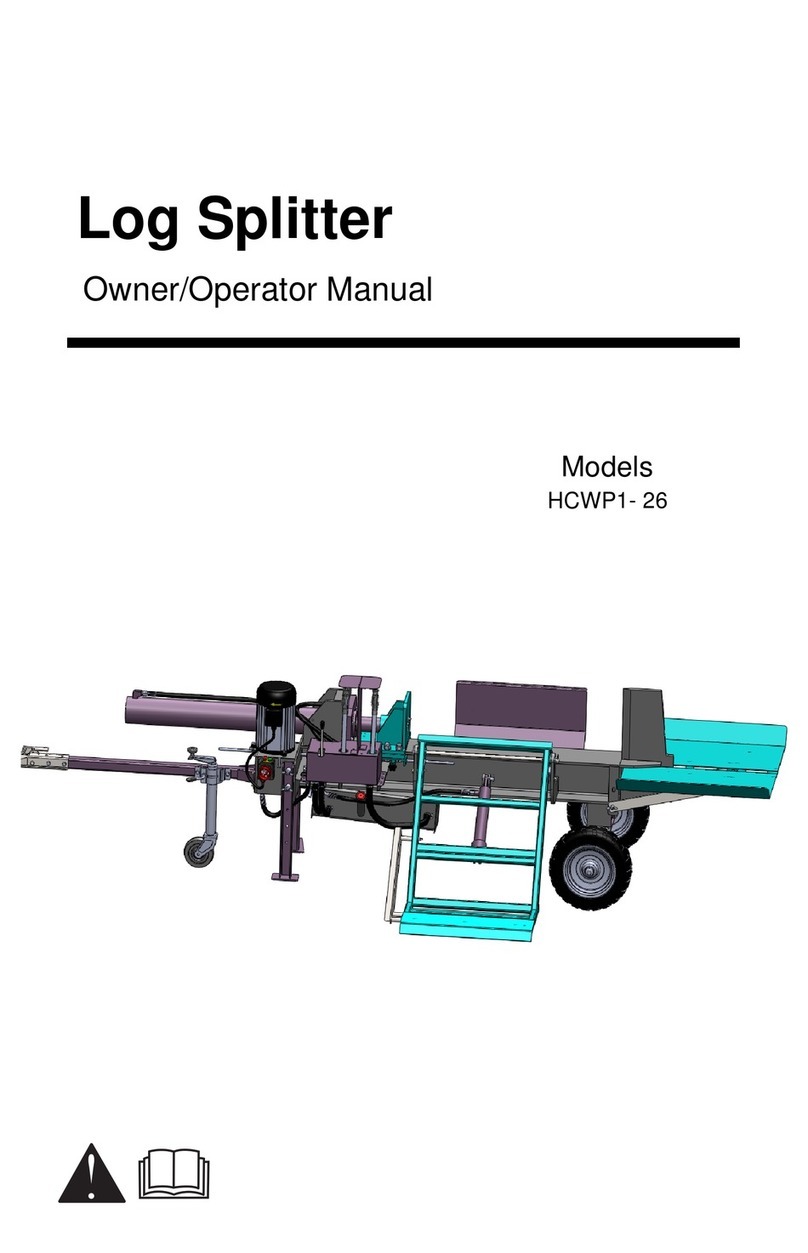
Primus
Primus HCWP1- 26 Owner's/operator's manual

Woodstar
Woodstar lv 60H Translation from the original instruction manual

Wen
Wen 4225 user manual

Maaselan Kone Oy
Maaselan Kone Oy Hakki Pilke 37 Series Instructions for assembly, operation and maintenance

COX
COX l2T owner's manual
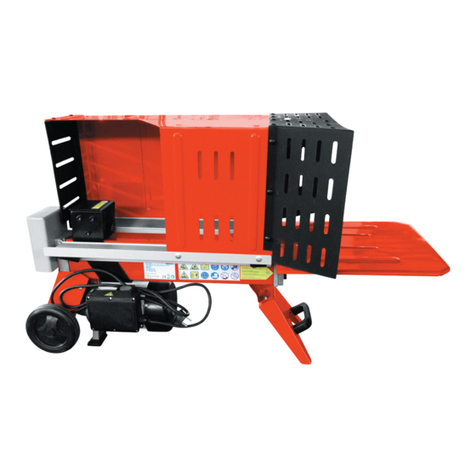
Dovre
Dovre 18163 instruction manual
